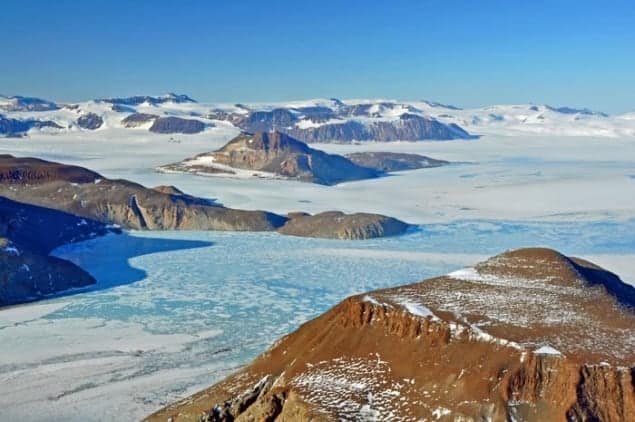
The first search for magnetic monopoles in mantle-derived polar igneous rocks – thought to be likely to contain a higher ratio of monopoles to matter – has been conducted by researchers in Switzerland. The team analysed 23.4 kg of samples from Arctic and Antarctic regions. While no monopoles were found, the monopole to nucleon ratio in the search samples was constrained, with a 90% confidence level, to an upper limit of 1.6 monopoles per 1028 nucleons. The team claims that its study, which adds to existing matter-bound monopole searches, has comparable or better sensitivity than the most extensive meteorite search to date.
Magnetic monopoles were famously predicted by Paul Dirac in 1931 as a way of explaining electric charge quantization. Their existence is also predicted by a number of grand unification theories, but the much-anticipated particle has so far remained elusive.
“The magnetic monopole is a truly fascinating hypothetical object – it explains electric charge quantization and it is needed in theories that unify the fundamental interactions,” says lead researcher Philippe Mermod, from the University of Geneva. “This makes us wonder why it has never been found in nature, as its non-existence would be a complete mystery.”
Cosmic origins?
It is believed that monopoles might be created within high-energy particle accelerators, such as the Large Hadron Collider. However, if monopoles are very heavy, the beam energy could be insufficient to create them in particle collisions. In this case it could be that the only events energetic enough to produce monopoles happen in the cosmos, or occurred just after the Big Bang.
“In such a case, monopoles should be around us: either travelling freely through space or bound to matter,” explains Mermod, “but [past] experiments were unable to observe any in hundreds of kilograms of terrestrial matter, and even in asteroids and rocks from the Moon, showing that if they are there, they are extremely rare.”
Mermod and his team believe that the key to finding monopoles might lie not with more powerful accelerators or the analysis of larger amounts of source material, but with novel search designs.
During its formation, the Earth was molten, and has since differentiated into a number of chemically distinct layers – the crust, the mantle, and the inner and outer core. During this stage, any monopoles bound to the matter that formed the Earth would likely have sunk towards the core. The crust, therefore, is expected to be depleted in such stellar monopoles – monopoles already trapped in stardust before the formation of our solar system.
In-depth look
Monopoles in the solid mantle, however, would be restricted in their movement and, regardless of their polarity and the magnetic-field direction, would be slowly moved along in line with mantle convection. On reaching the liquid core, their mass would pull them towards the Earth’s centre, before being attracted pole-ward by their magnetic charge.
Mermod and colleagues therefore predict that monopoles might be distributed throughout the mantle, up to a distance of 3400 km – the core radius – from the Earth’s magnetic axis. Rocks from polar mantle-derived sources are therefore potential candidates in the search for monopole-bearing material. Samples selected for this study were mainly confined to mantle-derived rocks from high (greater than 63 degrees) latitudes.
The team searched for monopoles in the samples by looking for the signature of a persistent current in a loop of superconducting material – a SQUID-based rock magnetometer – that is housed in a shielded room at the Laboratory of Natural Magnetism in Zurich.
Probing polar rocks
“Polar volcanic rocks were never probed for monopoles before,” says Mermod. He goes on to explain that since his calculations showed that the gravitational/electromagnetic force balance was advantageous for a range of monopole masses and charges, and he had access to a magnetometer that was able to detect the signature of a monopole in rock samples, he decided “that this needed to be done. There was truly a chance that monopoles would be spectacularly discovered”.
In addition, the team also analysed rocks with chemical compositions that hint at deep mantle origins. These included: basaltic rocks extruded above hotspots where local heat increases in the mantle cause an upwelling plume; samples from large igneous provinces – areas of massive flood basalt deposits that have been connected to continental break up and mantle plume activity; lava containing lherzolite nodules that have been transported, unaltered, up from the mantle; and basaltic lava from Coleman Nunatak, a ridge of rock located at the head of the Berry glacier in Antarctica, the high 206Pb/204Pb ratios of which indicate a low extent of melting and deep origin.
Control samples for the study were taken from crust-derived lava from an Antarctic subduction zone and from low-latitude hotspots (Hawaii) and mid-ocean ridges (the Mid-Atlantic Ridge and the East Pacific Rise), as these should be depleted of monopoles.
Continuing the hunt
The monopole hunt in matter, however, will not end here. “The future of searches for monopoles trapped in matter depends on possible access to better instruments based on new technologies, or to exotic material samples,” Mermod says. “As soon as new material becomes available – for instance, returned samples from asteroid or comet survey missions – it will be important to probe it for monopoles.”
A pre-print of the research is available on the arXiv server.



